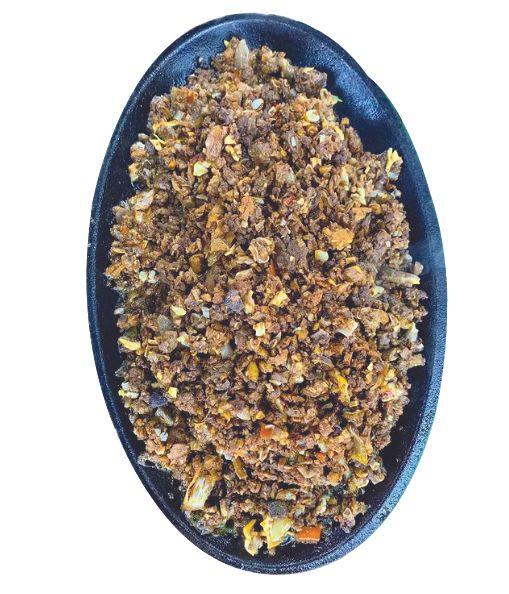Tinunis to die for
Rhapsodizing over this bopis-like dish from a farm in Tiaong, Quezon
By AA Patawaran
At A Glance
- Made of minced pig's lungs, heart, and liver, it is very similar to bopis, sautéed as well with chopped pig innards, onion, tomato, garlic, and pepper and stirfried until crispy.

I am writing this in the small hours of the Philippines’ 126th Independence Day. That’s because I am reminded of a dish that made such a mark on me when, in July 2022, I found myself in Tiaong, Quezon at the very heart of the southern Tagalog mainland, where we first declared ourselves independent of Spain on June 12, 1898.
The dish is called tinunis, apparently Spanish in origin that we, like many other things from our colonial past, have made completely our own. Made of minced pig’s lungs, heart, and liver, it is very similar to bopis, sautéed as well with chopped pig innards, onion, tomato, garlic, and pepper and stir-fried until crispy.
Unlike bopis, as it is presented in other regions around the country, the Tiaong tinunis, or the tinunis served to me in Tiaong, is dry. It doesn’t come with radish or carrots, and it’s just the way I want it, best eaten with steamed white rice or leftover rice or no more rice, once you realize eating it is also rice overload. It’s also bar chow or pulutan, as we call it in Tagalog, the perfect accompaniment to beer or whisky or gin or vodka or whatever poison you choose on a drinking spree with friends.
When I posted about it in July 2022, it was shared generously on other food sites. I did write in my post that I would drive down to Tiaong just for tinunis, that I would drive 10 hours more for tinunis, that I, like Magellan, at the risk of scurvy and starvation, would circumnavigate the world for tinunis. Yes, I would, especially as cooked by carinderia king Melvin de Castro Tanyag, whose smash hit Melvin’s Carinderia in western Bicutan has allowed him to build MDT Farm in Tiaong, where he was born and raised poor, as he told me and my friends to highlight how much it meant to him to own this farm, to build this farm from scratch with money he earned from his one true love— food and cooking. He told us this while, under a lush mango tree, he served us some of his specialties, tinunis included, but also dishes he grew up with like the famous pancit habhab or his version of it overloaded with miki Lucban, pepper, pork, semi-fried shrimp, soy sauce, and sayote, as well as a very generous topping of fish balls, kikiam, and red and spring onions. Also served were suam na patola or silk squash soup cooked a la pancit molo, pork blood stew or dinuguan or pinalabuan, as it is called in Tiaong, with labong or bamboo shoots, and tindág or giant skewers of meat, fat, and innards grilled over open fire in his outdoor kitchen. But the tinunis is why I regret not being true to my word when I said I would return to Tiaong for tinunis.
In July 2022, the pandemic was still at its height and, at that point, although we had long started to venture out of our masks, PPEs, and lockdowns, there was no end in sight for the global health emergency. Come to think of it, my Tiaong visit was around the time that, along with the then newly installed President of the Republic, Ferdinand R. Marcos Jr. (PBBM), I acquired Covid-19. I know because I started to feel the symptoms one day before the presidential inauguration on June 30, 2022 and I had to inform Michele Boccoz, then ambassador of France to the Philippines, and Jana Sediva, then ambassador of the Czech Republic, with whom I spent the whole afternoon on June 28, for fear that I might have infected them. They were both invited to the inauguration. As fate would have it, PBBM and many of his guests at the inauguration got the virus in July just as I was recovering from it.
But back to tinunis. It’s as good as any dish to think of in memory of our struggles for independence as well as in acknowledgment of the fact that, yes, we need to realize that we have so much worth fighting for, as did the heroes of the region, many of whom, like Jose Rizal from Laguna, Emilio Aguinaldo from Cavite, Apolinario Mabini from Batangas, and Hermano Puli or Apolinario de la Cruz from Quezon Province, “the first Filipino martyr to the cause of religious liberty,” according to Filipino historian Gregorio Zaide.
I think I’d fight—and die—even just for tinunis at MDT Farm in Tiaong, Quezon, but here I am again making promises I cannot keep. I do think tinunis deserves its day, though it is almost never ever included in the list of the culinary and gastronomic wonders with which the Philippines is currently turning heads and triggering appetites in the world and its community of foodcurious nations.